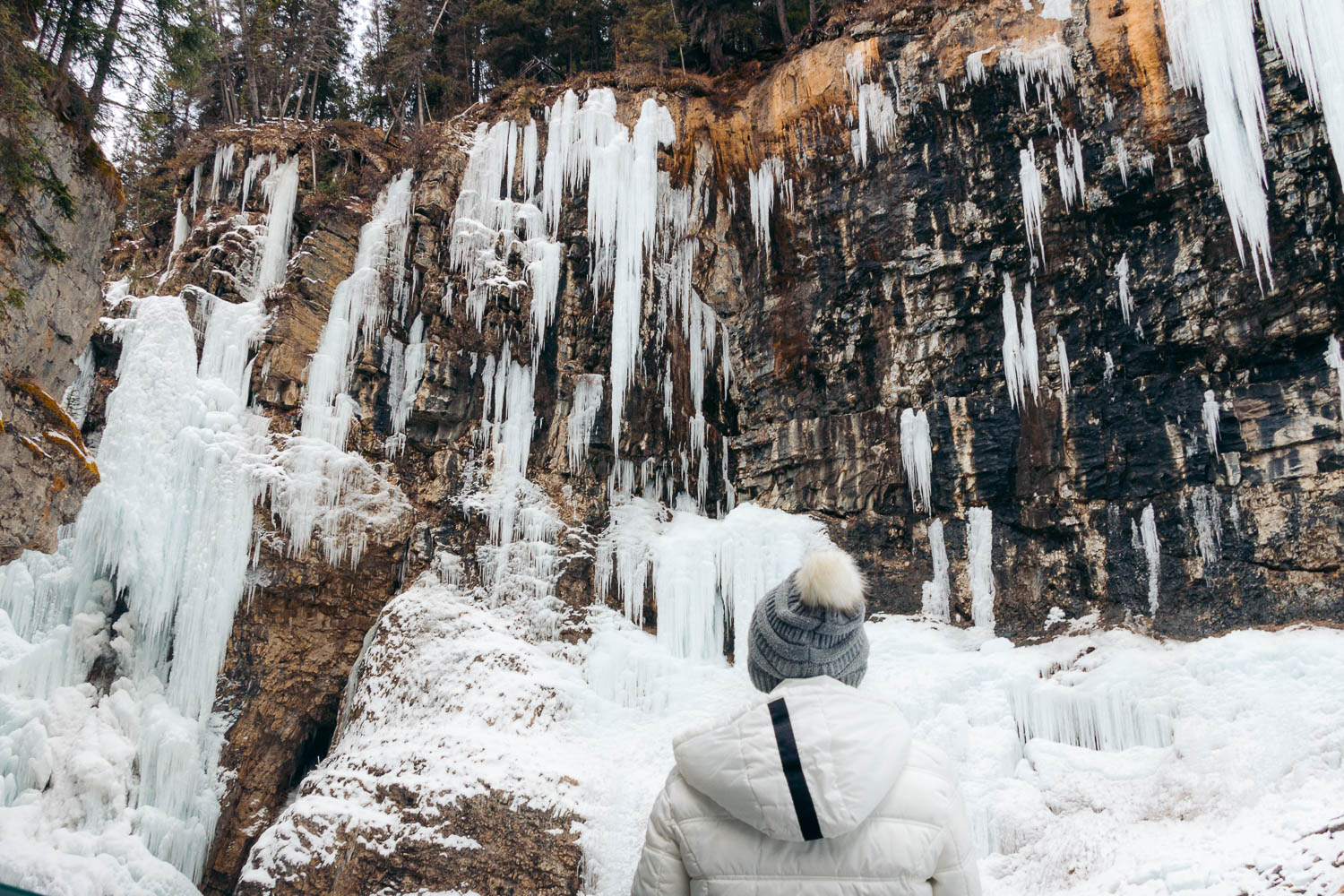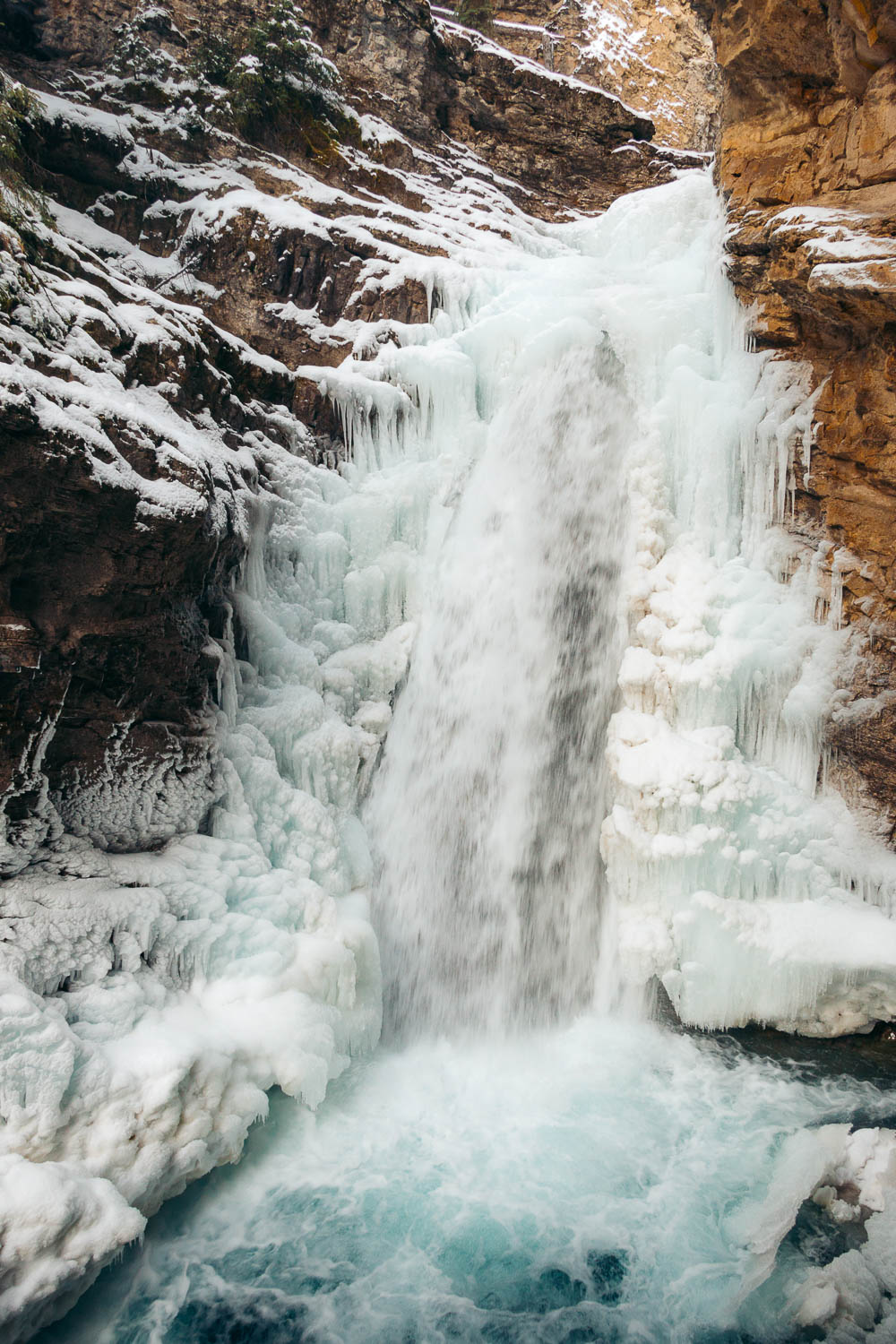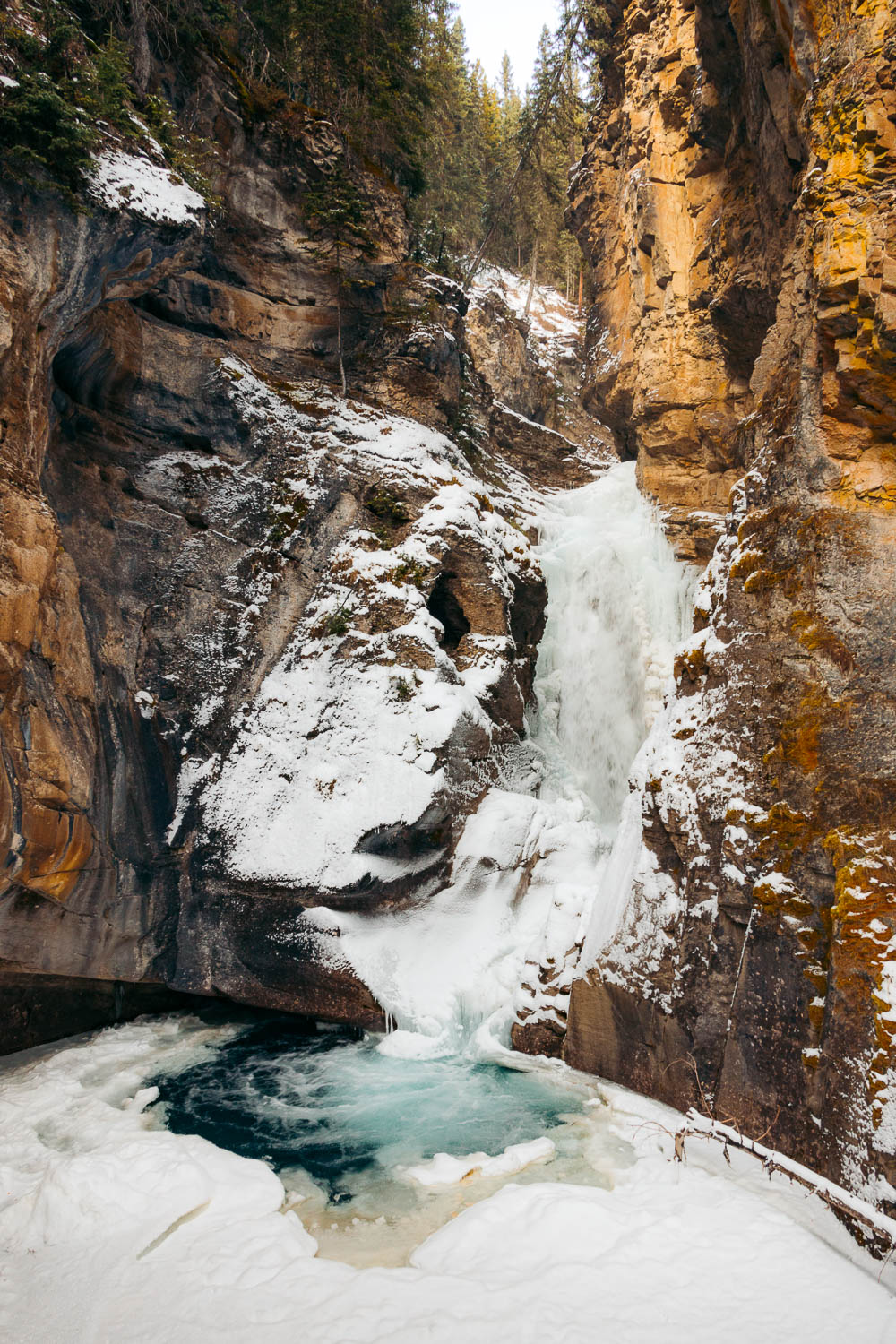Frozen waterfalls are the most magical part of Johnston Canyon in Banff National Park during the winter season.
Last updated: March 21, 2025
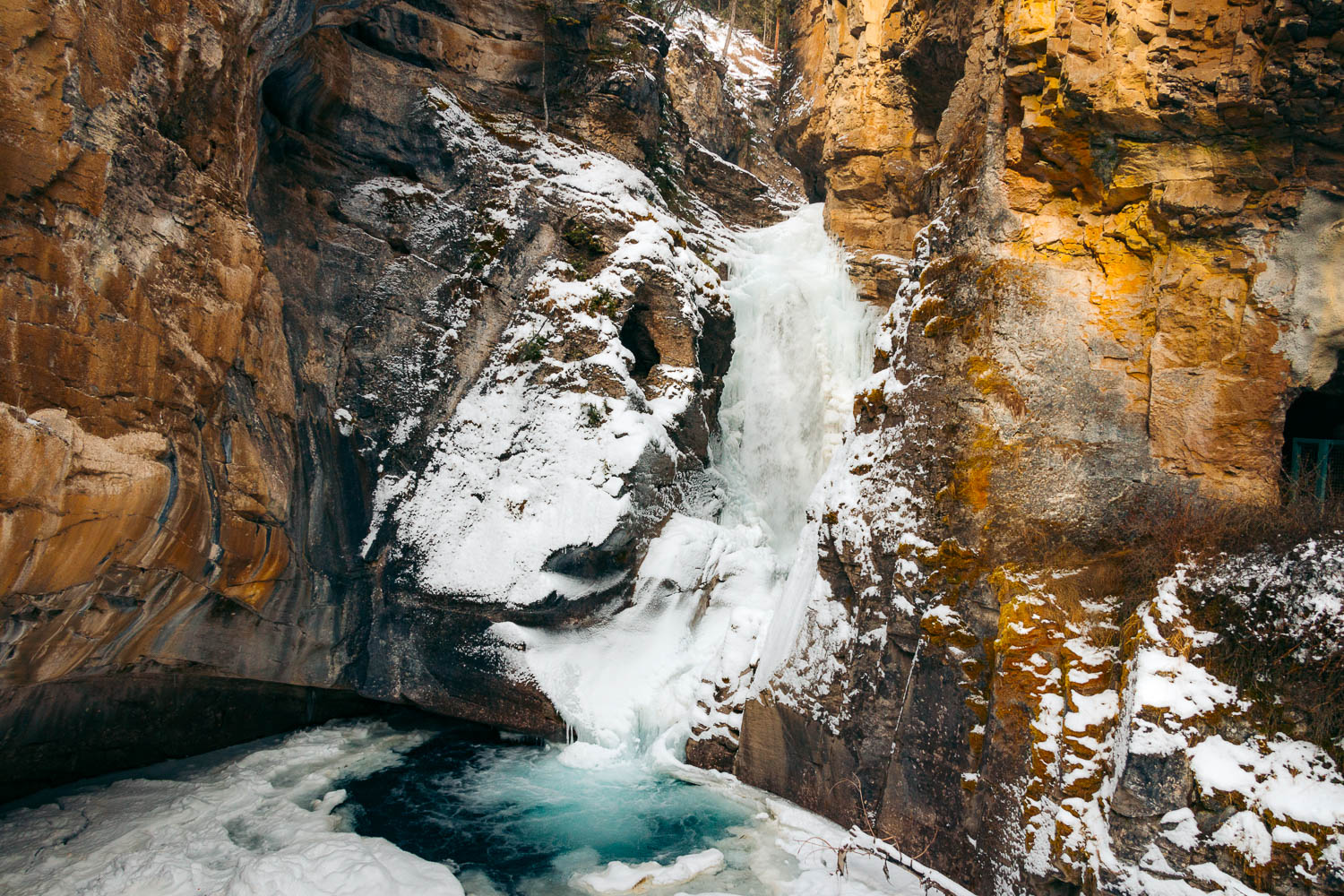
The Off-Season is About the Right Time to Hike in Johnston Canyon
Surrendering to freezing Canadian winter, Johnston Canyon, a popular hiking place in Banff National Park, puts a temporary stop to its season-long “crying”. Where once gurgling waterfalls slid down the imposing canyon walls, now large icicles fill up the deep abyss.
Frozen waterfalls in Johnston Canyon are a sight to behold. Some are tiny, barely noticeable amid the fluffy bleached blanket. Others bedeck the gully with sizable, needle-like crystals that hang from the towering cliffs like Christmas ornaments.
If you arrive in early November, which is considered the beginning of the winter season in the Canadian Rocky Mountains, the largest waterfalls in Johnston Canyon are only half frozen. Their heavy flows still continue to fight against the bitterly cold weather. Yet the frost creeps in, enchaining first the sides and soon the entire bodies of the dazzling members of the Johnston Canyon’s waterfall family.
How Many Waterfalls are in Johnston Canyon
Impressed with the winter opulence that showed up in crunching snow under the feet, fuzzy “mittens” on the branches of the trees, and thousands of frozen drips all over, I forgot to count how many waterfalls resided in Johnston Canyon.
I’m inclined to agree with those sources that say seven.
So here it is. You can see seven frozen waterfalls in Johnston Canyon from as early as the beginning of November through March. The most popular sites are undoubtedly Lower and Upper Johnston Canyon Falls. Smaller plunge falls and cascades nested between these two giants include Stella Falls, Tunnel Falls, and Marguerite Falls.
Hiking to Frozen Falls in the Canyon
The cold, subzero temperatures may force the abundant waterfalls in Johnston Canyon to freeze over in the winter, but they hardly affect the canyon itself. Quite the opposite, with the frosty cover on the ground and glistening icicles all over the cliff walls, the place looks wintry festive.
Hiking along the Johnston Canyon Trails in pursuit of the frozen waterfalls becomes a sheer delight. A pleasure that is intensified by a notably reduced stream of winter visitors.
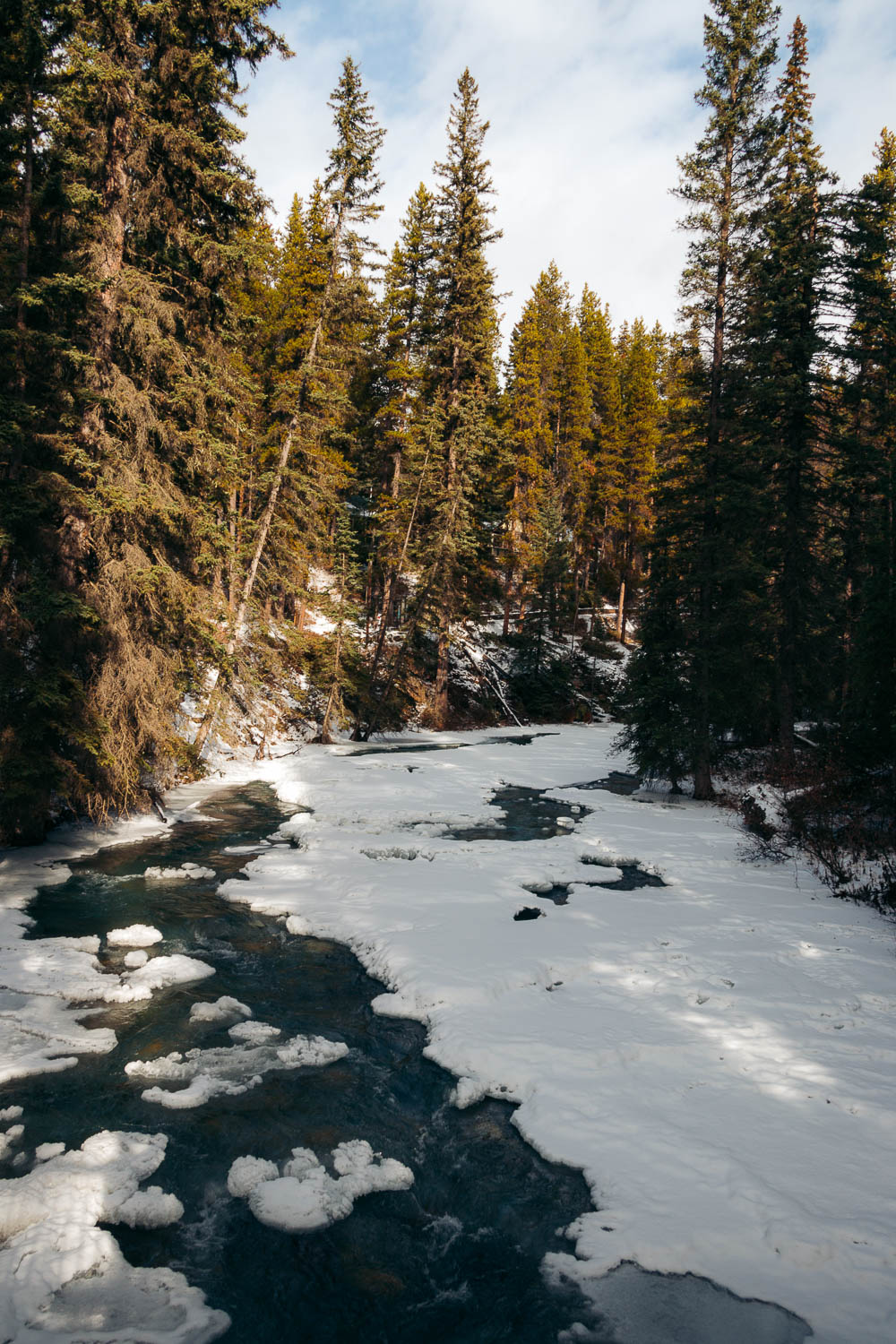
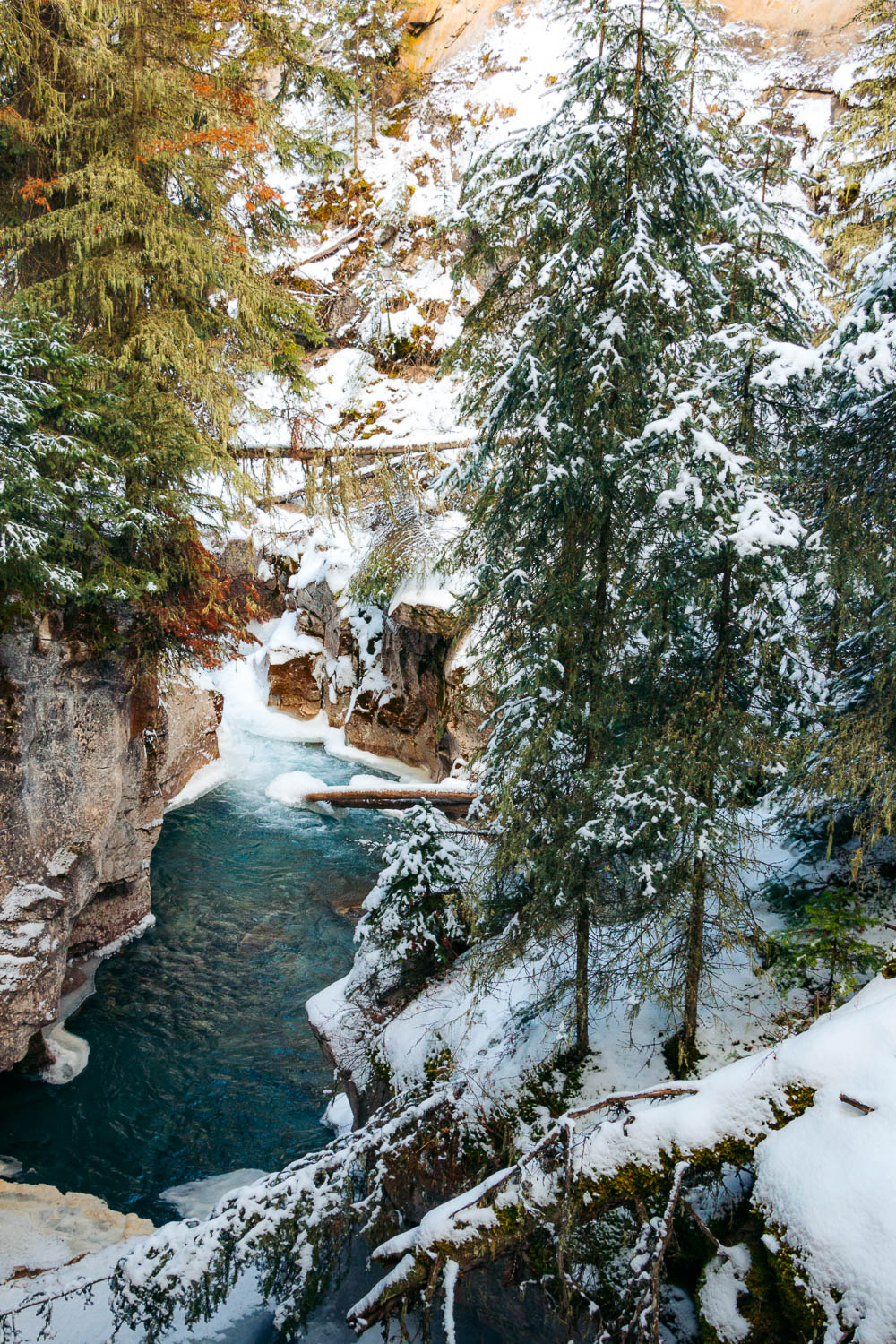
A COMPLETE GUIDE TO HIKING JOHNSTON CANYON WATERFALL TRAIL
Johnston Canyon Trail (Lower Falls)
- Length: 1.2 kilometers one way
- Elevation gain: 30 meters
- Time: 1-1.5 hours
- Difficulty: Easy
- Trailhead: Johnston Canyon Parking Lot
Johnston Canyon Trail (Upper Falls)
- Length: 2.5 kilometers one way
- Elevation gain: 120 meters
- Time: 2-3 hours
- Difficulty: Easy
- Trailhead: Johnston Canyon Parking Lot
The Johnston Canyon Trailhead
The trailhead to the frozen waterfalls in Johnston Canyon is nestled along the Bow Valley Parkway, roughly 32 kilometers northwest of the town of Banff, home to the unique Cave and Basin National Historic Site.
The next closest crown jewel of the park that you can easily reach by car even in the winter is Lake Louise. Mostly likely frozen over by this time, the lake snuggles down into a snowy wrapper approximately 33 kilometers north of the canyon, along the Trans-Canada Highway.
A large parking lot near the trailhead attests to the popularity of the hike. Even at the beginning of the winter season when the majority of the waterfalls in and around Johnston Canyon stood frozen over or were halfway through the icing process, the area was more than half full. The trail, however, wasn’t crammed full of people.
With the majority of the winter visitors lingering near the half-frozen Lower Falls, we had the entire trail to ourselves for long periods of time between Lower and Upper Johnston Canyon Falls.
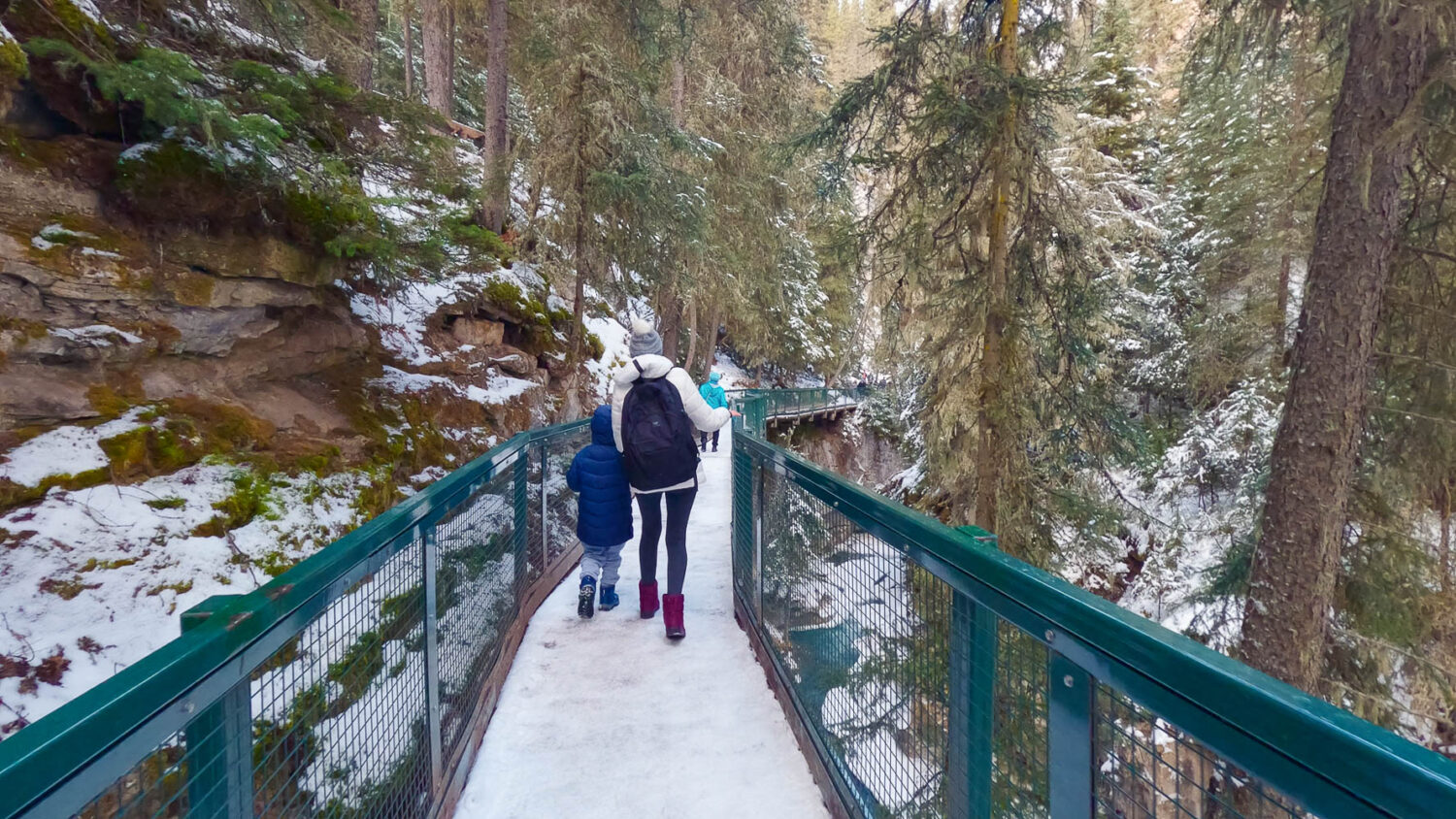
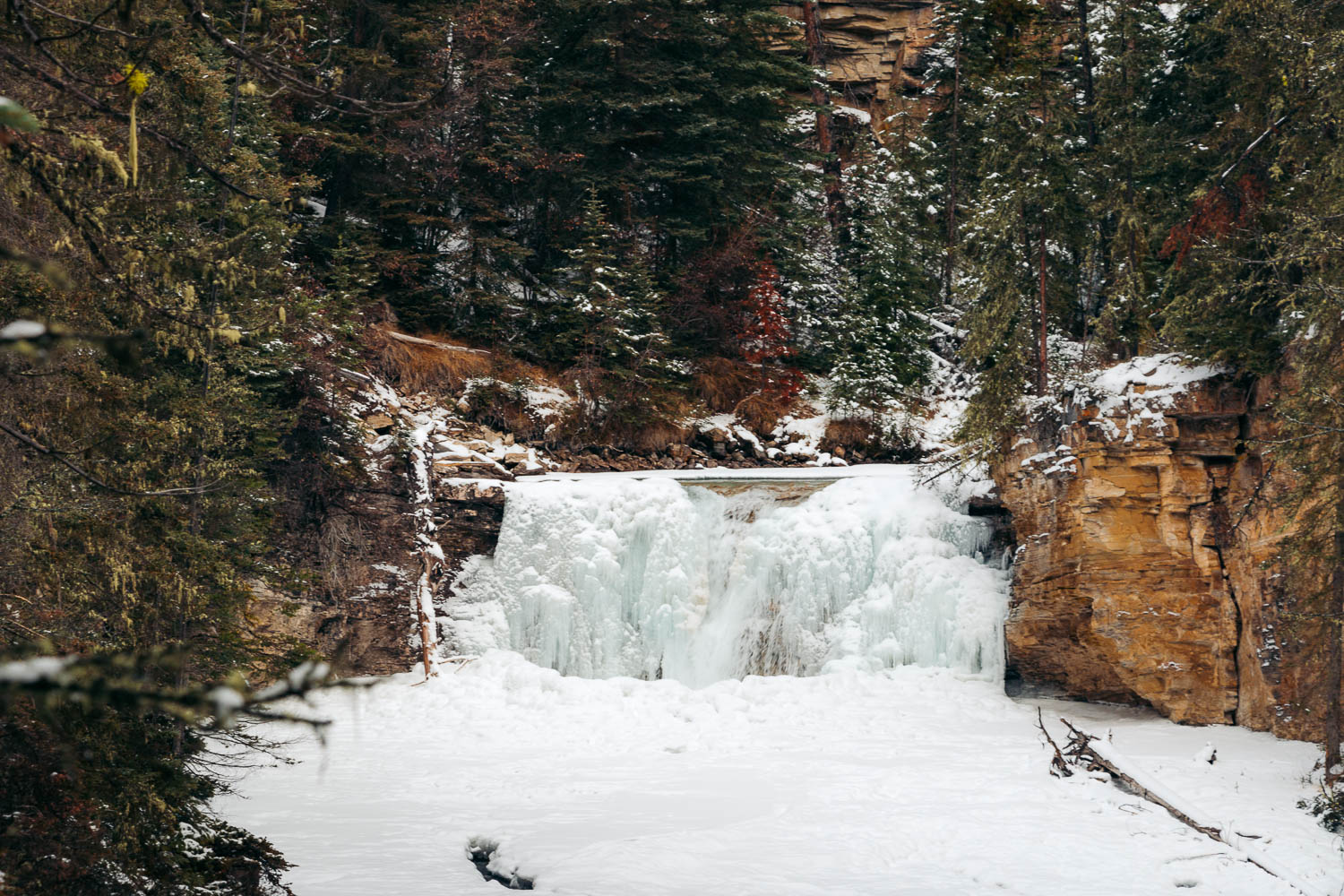
Hiking the Johnston Canyon Trail
The entire trail from the Johnston Canyon parking lot to the frozen Upper Falls is 5 kilometers (round trip) long. The path starts as a hike through an evergreen forest At the beginning of the winter season, the sound of still babbling Johnston Creek fills your ears before the eyes can see it.
Soon the trail approaches the edge of the canyon and stays there for the duration of the entire hike, shortly veering into the woods and returning as quickly.
Metal railings separate the trail from Johnston Canyon where the waterfalls now drop their heavy frozen tear-icicles. In the narrow sections of the abyss where the sheer cliffs are void of any ledges, big enough to form a trail, raised metal platforms serve as connecting bridges.
You can hike the entire trail or return to the parking lot as soon as you quench your thirst for discovering the frozen waterfall of Johnston Canyon after the first, second, or third icy wonder.
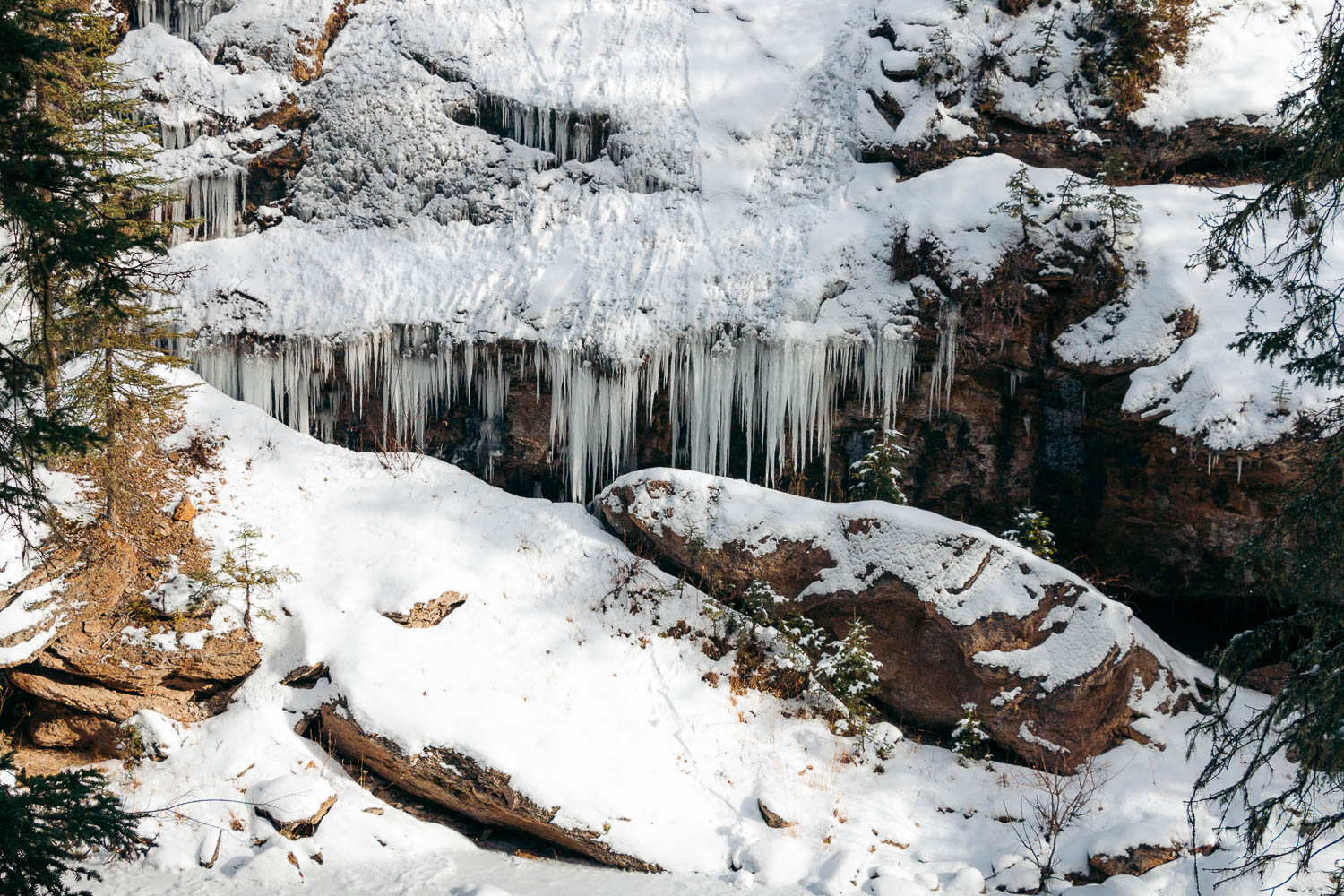
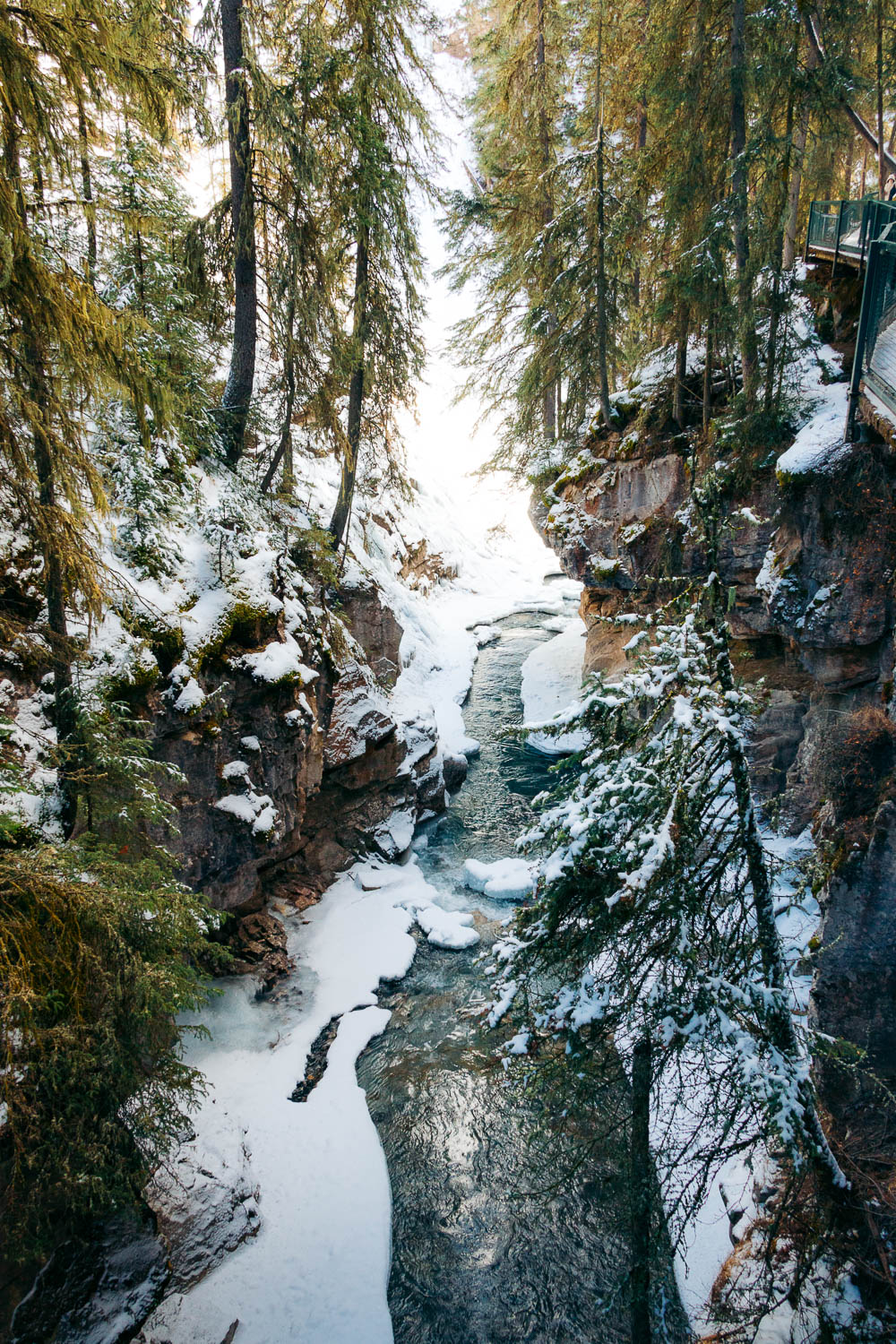
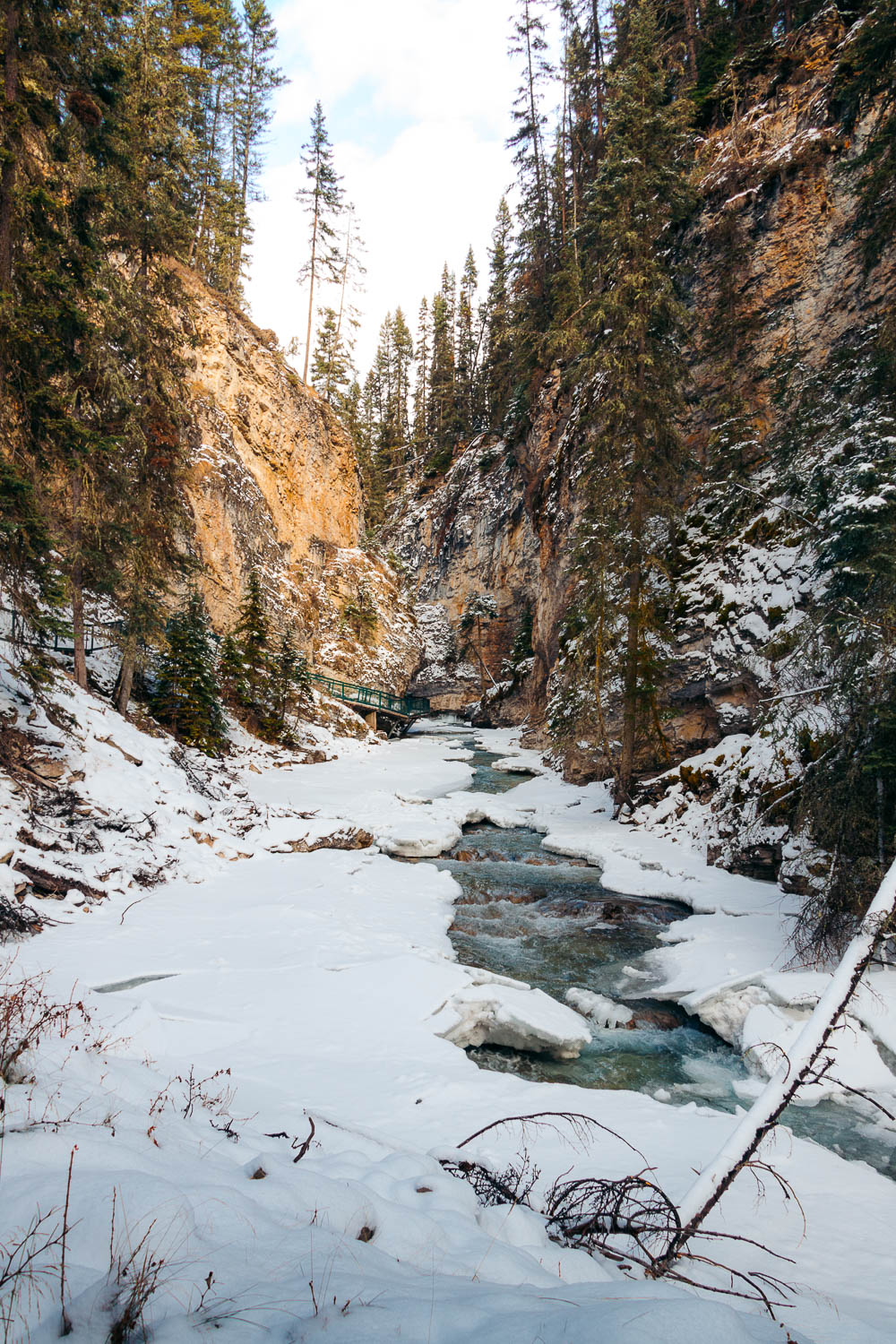
Frozen Lower Johnston Canyon Falls
As I stated before, the two largest waterfalls, Upper and Lower Falls, inspire nature lovers to hike deeper into Johnston Canyon in the midst of the Canadian freezing winter.
Lower Falls ensconces itself behind a short duck-through tunnel, 1.2 kilometers from the Johnston Canyon Trailhead. The trail is relatively flat until it reaches a trail junction. The left fork continues uphill through the wintry realm of the canyon to its largest frozen marvel, Upper Johnston Canyon Falls.
The right fork swerves downhill. Jaw-dropping views of the first frozen waterfall open up almost immediately as you approach a metal footbridge suspended over Johnston Canyon.
Following the falls’ lead, a rather big pool at the foot of the waterfall also quickly responded to the subzero temperatures in early November. Except for a small turquoise puddle that the forceful stream of the half-frozen waterfall emptied into, the pond was trammeled by ice.
I spent a good 10 minutes on the bridge, admiring the wintry opulence that surrounded the first properly frozen waterfall halfway through Johnston Canyon, before hunkering through the cliff tunnel.
On the other side of the passage, Lower Johnston Canyon Falls looked grander. So graceful. Such an inseparable part of the cliffs towering behind it. And still so deafening during the first day of the winter season…
The largest waterfalls in Johnston Canyon freeze over between December and late March. At the beginning of the winter season, which starts as early as mid-October, the falls are normally partially tamed. Yet the persistent ice continues creeping into the sides and upper sections of the falls until there is no more room left for the water to escape.
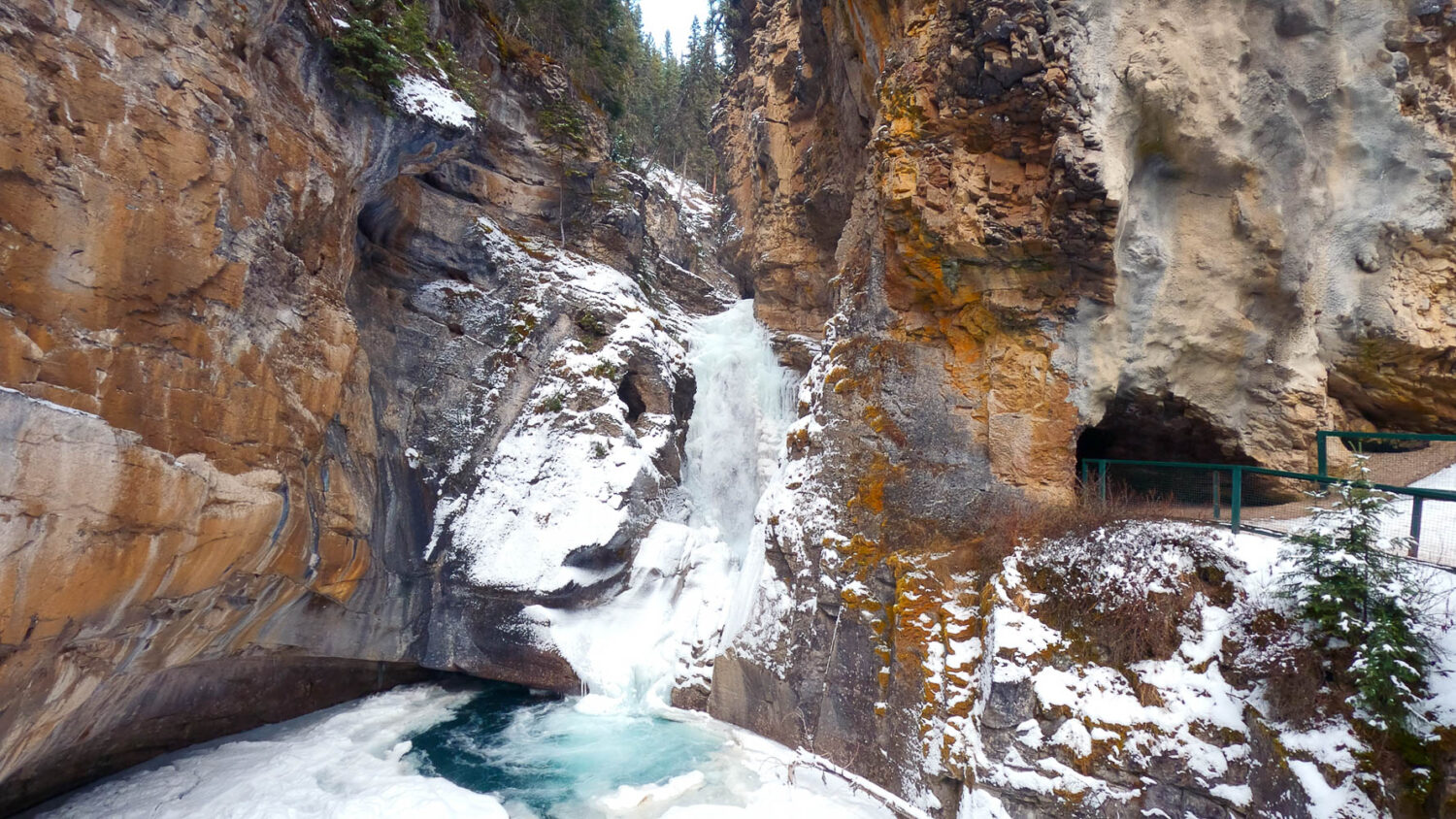
Frozen Upper Johnston Canyon Falls
Hefty crystals perch along a 30-meter cliff, 2.5 kilometers away from the Johnston Canyon Trailhead. Located only 1.3 kilometers away and 90 meters higher than Lower Falls, Upper Johnston Canyon Falls transforms into an exclusive frozen sculpture by November.
The trail to this remarkable masterpiece levels out shortly after you conquer a steep incline near the trail junction with Lower Johnston Canyon Falls. Still staying mostly by the cliff edge, the path shortly swoops into the forest several times.
Upper Johnston Canyon Falls hibernates in its frozen attire the entire winter. The icy shell starts melting by mid- or late March.
Are Frozen Waterfalls in Johnston Canyon Worth Visiting?
I didn’t know that I needed to have “to see a frozen waterfall” on my bucket list until I hiked to the first icy wonder of Johnston Canyon. The sight was incredible. I couldn’t find the right words to describe what I felt while gazing at the frozen structure in front of me. A phenomenon that just a few weeks ago couldn’t bear any constraints.
A growing realization of how powerful nature was washed over me with new intensity. Was it worth hiking to these frozen waterfalls in Johnston Canyon? A thousand times yes!
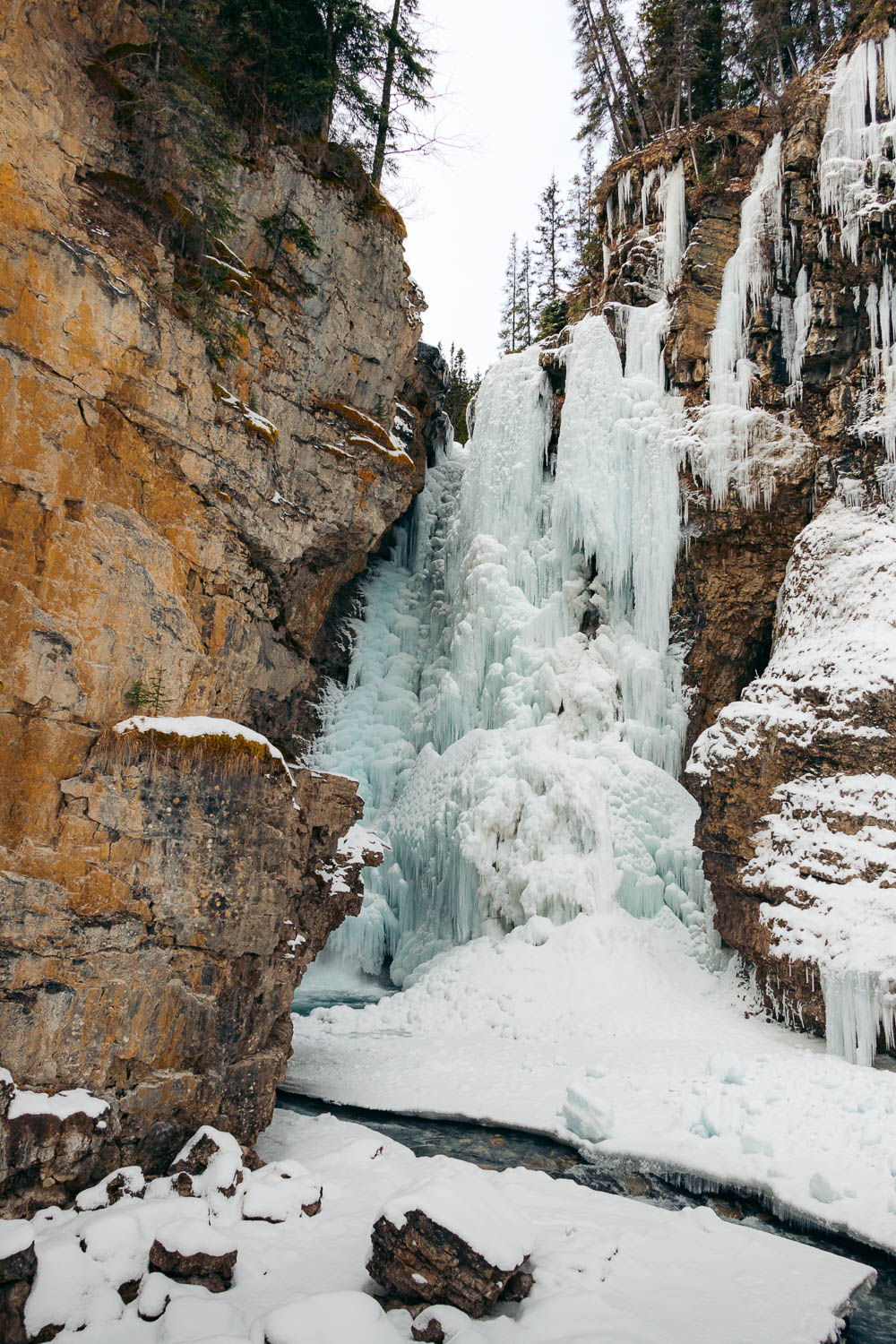
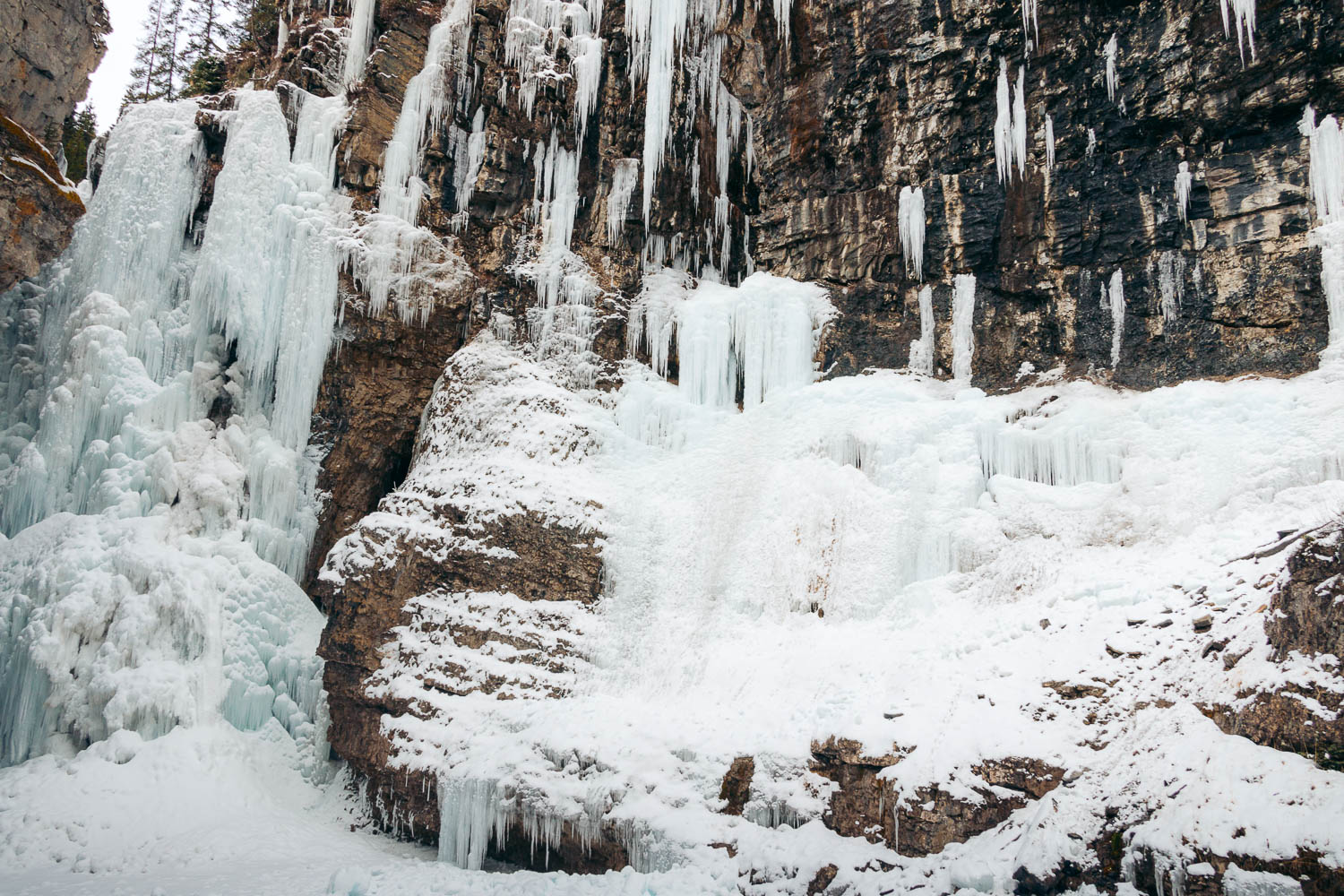
Things to Know Before Hiking in Johnston Canyon
Is the Trail Slippery in Winter?
Under the feet of hundreds of hikers, the fresh layer of snow quickly flattens. It doesn’t take long for the icy crust to form on top of it. Yet while still mostly rough, the trail becomes very slippery on the tiniest of slopes.
Holding on tightly to the metal railings as if my life depended on it was the only way I hiked the entire Johnston Canyon Trail and admired its frozen waterfalls without performing any awkward falls in front of other hikers.
So don’t rush. Proceed slowly. If possible, look for “untrodden” spots where the trail borders the trees and the snow is still untouched.
TIP: Peyto Lake, another beautiful winter hike in Banff National Park, is roughly 76 kilometers no. Even less crowded at this time, the place looks like a real winter wonderland and, like the waterfall trail in Johnston Canyon, is quite easy to hike to.
Do You Need Microspikes to Hike the Johnston Canyon Trail in Winter?
Although not required, microspikes are highly recommended while hiking to the winter bedizened waterfalls in Johnston Canyon. The trail is packed with snow and ice most of the time during the off-season.
Are There Any Bears in Johnston Canyon?
Hiking to the frozen waterfalls in Johnston Canyon is the least likely activity to put you face to face with a wild bear. First, the bears hibernate in the winter. Second, Banff’s wildlife normally avoids well-trafficked areas, such as the Johnston Canyon Trail.
Yet, it’s an alpine wilderness you are trekking through. So it never hurts to keep a vigilant eye on the surroundings and carry bear spray.
Can You Hike in the Canyon with Strollers and Wheelchairs?
While the sections of the Johnston Canyon Trail near the trailhead can accommodate both strollers and wheelchairs, the path narrows and becomes rather unsuitable for the “wheels”. You can still try to reach Lower Falls during the summer season. In the winter, a hike to the frozen waterfalls along the slippery Johnston Canyon Trail is a rather challenging pursuit.
Is the Trail Dog-Friendly?
Pets are welcome on the Johnston Canyon Trail, but must be leashed at all times.
Is the Canyon Open Year Round?
The Johnson Canyon Trail is one of the favorite hiking places in Banff National Park. The area is open year round and features spectacular views during all seasons. Frozen waterfalls are the most captivating sights in Johnston Canyon during the winter season.
TIP: For more information about the area, what to know and how to visit, please read our article Things to Know Before Visiting Banff National Park. For travelers visiting national parks in the U.S. and Canada, we have a detailed article, explaining the differences in admission, parking, and transportation within the parks.
